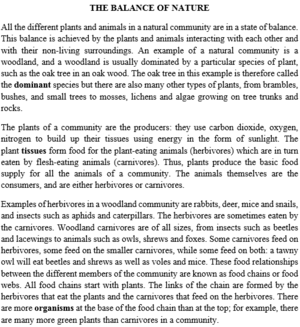Read the following passage and mark the letter A, B, C, or D to indicate the correct answer to each of the following questions from (46)to (55)
Animals have an intuitive awareness of quantities. They know without analysis the difference between a number of objects and a smaller number. In his book " The natural History of Selboure " (1786 ) , the naturalist Gilbert White tells how he surreptitiously removed one egg a day from a plover's nest , and how the mother laid another egg each day to make up for the missing one . He noted that other species of birds ignore the absence of a single egg but abandon their nests if more than one egg has been removed. It has also been noted by naturalists that a certain type of wasp always provides five - never four, never six - caterpillars for each of their eggs so that their young have something to eat when the eggs hatch . Research has also shown that both mice and pigeons can be taught to distinguish between odd and even numbers of food pieces.
These and similar accounts have led some people to infer that creatures other than humans can actually count. They also point to dogs that have been taught to respond to numerical questions with the correct number of barks, or to horses that seem to solve arithmetic problems by stomping their hooves the proper number of times.
Animals respond to quantities only when they are connected to survival as a species - as in the case of the eggs - or survival as individuals - as in the case of food. There is no transfer to other situations or from concrete reality to the abstract notion of numbers. Animals can "count" only when the objects are present and only when the numbers involved are small - not more than seven or eight. In lab experiments, animals trained to "count" one kind of object were unable to count any other type. The objects, not the numbers, are what interest them. Animals’ admittedly remarkable achievements simply do not amount to evidence of counting, nor do they reveal more than innate instincts, refined by the genes of successive generations, or the results of clever, careful conditioning by trainers.
The word “they” refer to
A. numbers
B. genes
C. animals
D. achievements





Đáp án là D. they = achievements: thành tựu
Câu: Animals’ admittedly remarkable achievements simply do not amount to evidence of counting, nor do they reveal more than innate instincts
Nghĩa các từ còn lại: numbers: các con số; genes: các gen; animals: các động vật